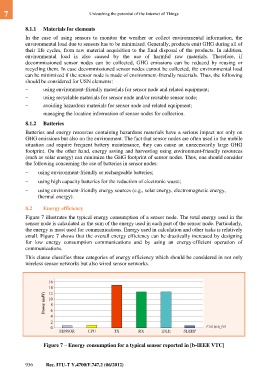Page 950 - Unleashing the potenti al of the Internet of Things
P. 950
7 Unleashing the potential of the Internet of Things
8.1.1 Materials for elements
In the case of using sensors to monitor the weather or collect environmental information, the
environmental load due to sensors has to be minimized. Generally, products emit GHG during all of
their life cycles, from raw material acquisition to the final disposal of the products. In addition,
environmental load is also caused by the use of harmful raw materials. Therefore, if
decommissioned sensor nodes can be collected, GHG emissions can be reduced by reusing or
recycling them. In case decommissioned sensor nodes cannot be collected, the environmental load
can be minimized if the sensor node is made of environment-friendly materials. Thus, the following
should be considered for USN elements:
– using environment-friendly materials for sensor node and related equipment;
– using recyclable materials for sensor node and/or reusable sensor node;
– avoiding hazardous materials for sensor node and related equipment;
– managing the location information of sensor nodes for collection.
8.1.2 Batteries
Batteries and energy resources containing hazardous materials have a serious impact not only on
GHG emissions but also on the environment. The fact that sensor nodes are often used in the mobile
situation and require frequent battery maintenance, they can cause an unnecessarily large GHG
footprint. On the other hand, energy saving and harvesting using environment-friendly resources
(such as solar energy) can minimize the GHG footprint of sensor nodes. Thus, one should consider
the following concerning the use of batteries in sensor nodes:
– using environment-friendly or rechargeable batteries;
– using high capacity batteries for the reduction of electronic waste;
– using environment-friendly energy sources (e.g., solar energy, electromagnetic energy,
thermal energy).
8.2 Energy efficiency
Figure 7 illustrates the typical energy consumption of a sensor node. The total energy used in the
sensor node is calculated as the sum of the energy used in each part of the sensor node. Particularly,
the energy is most used for communications. Energy used in calculation and other tasks is relatively
small. Figure 7 shows that the overall energy efficiency can be drastically increased by designing
for low energy consumption communications and by using an energy-efficient operation of
communications.
This clause classifies three categories of energy efficiency which should be considered in not only
wireless sensor networks but also wired sensor networks.
16
14
12
Power (mW) 10 8
4 6
2
0 F.747.2(12)_F07
SENSOR CPU TX RX IDLE SLEEP
Figure 7 – Energy consumption for a typical sensor reported in [b-IEEE VTC]
936 Rec. ITU-T Y.4700/F.747.2 (06/2012)

